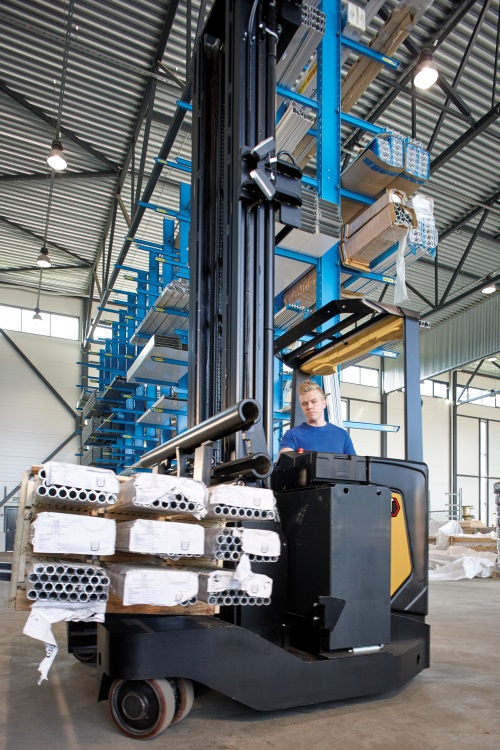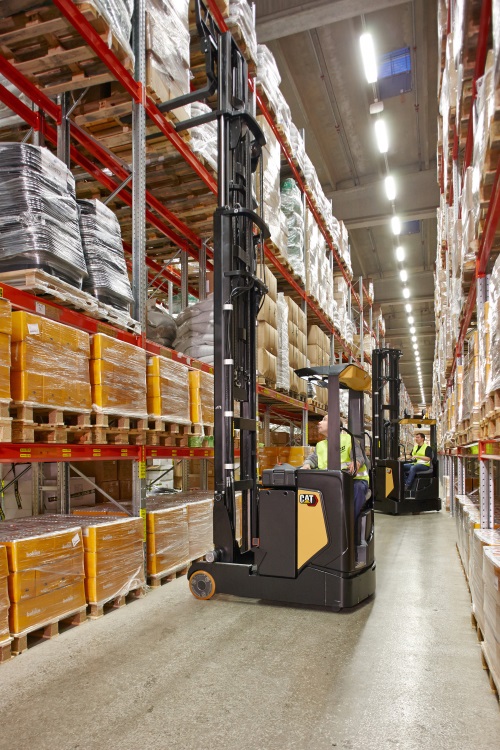How to prevent forklift truck overturns and load spillages
转载 2020-11-26 15:52 Cat® Source:Cat®At Cat® Lift Trucks, we believe in regularly reviewing and reinforcing the principles of safe forklift operator behaviour, to help embed them in our industry's culture.
The following guidelines focus on a single factor involved in many materials handling accidents: stability.
The load weight indicator option in the Cat® Multiway Reach truck helps the driver assessing the situation.
At its extreme, loss of balance in a forklift truck can cause it to overturn - sometimes resulting the driver's death, or life-changing injury, and always generating substantial danger and damage. But even a relatively small stability-related incident can be enough to make a forklift shed its load - endangering nearby workers and ruining valuable goods.
Here are ten top tips to keep your load on the truck, and your truck's wheels on the floor...
1、Load with care
Spread the load evenly and never lift it with just one fork. It should be set back firmly against the load backrest or the rear of the forks.
2、Don't overload
Stay within the truck's load capacity. Bear in mind that the rated capacity will be reduced when making high lifts or when using certain attachments. If in doubt, ask a supervisor.
3、Adjust to your load
Most loads are fairly 'inactive', but you should be especially careful with those whose behaviour can affect truck stability. They include freely suspended loads, and liquids in partly filled containers, both of which will rapidly shift their weight from one direction to another if moved abruptly. Insufficiently supported or hastily transported wide loads will similarly 'rock' the truck. Lower your speed, make all driving actions smooth, and carry less than the normal rated capacity.
4、Lower your forks
Driving with a raised load makes your truck much less stable, as its centre of gravity becomes dangerously high. Keep your forks and load within 150 mm of the floor when travelling, and tilt the mast fully backwards. It is also best practice to lower forks whenever the truck is parked. When manoeuvring a load into position at height, you should move at creep speed.
The safety-award winner Cat® NR-N2 reach truck range is a Red Dot Award recipient
5、Check surface conditions
Before operating a forklift truck across a work site, make sure you are aware of any surface hazards. Is there oil, grease, ice, water, mud or anything else on which it might slip? Is there a risk of wheels sinking into soft ground? Is the floor bumpy or uneven? Are there kerbs, steps, large bumps or other obstacles to negotiate? Each of these conditions can throw a truck off balance, so slow down and proceed with extra caution. One extra tip: when crossing railway tracks or kerbs, a diagonal approach is best.
6、Beware of slopes
Avoid steep ramps if you can. If slopes are unavoidable, drive slowly and don't turn the truck on them. When driving up or down a slope, keep your load uphill from you so it doesn't slide off. In other words, your forks should be in front of you while going up and behind you while going down. When travelling without a load, go forward rather than in reverse. Never stack or de-stack loads on an incline.
7、Corner slowly
Slow down when cornering. Excessive speed is one of the commonest causes of forklift truck overturns. The risk is even higher when combined with surface hazards, slopes or a raised load.
8、Drive smoothly
Jerky motion or sudden heavy braking may throw the load off your forks. Aim for a smooth take-off, avoid abrupt accelerations and turns, and anticipate stops with gentle deceleration.
9、Know your heights
Before driving through a doorway or lifting a load inside a building, make sure you know the door and ceiling heights. Your truck and its load could experience a nasty shock if clearance is insufficient.
10、Wear a seatbelt
This won't actually prevent an overturn, but it can save your life if it happens.
Relevant Info
More- Toyota launches MyToyota Portal to revolutionise forklift fleet management
- Clark crossover forklift shows its strength at Duisburg Zoo
- Crown forklifts boost Decostar’s warehouse productivity by 18%
- Bobcat unveils first lithium-ion 3-wheel forklift in major electric push
- Toyota’s Traigo_i scoops second major design award
- Hangcha Partners With Yuantong on First NA Forklift Shipment
- HELI Launches Major Production Base in Thailand
- Grand Opening of Hangcha Middle East in Dubai
- X Series Low Level Order Picker: Move as One
- 2025 HELI Global Dealer Conference Concludes Successfully

